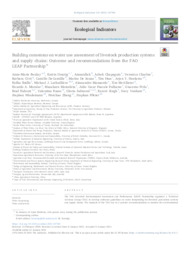Building consensus on water use assessment of livestock production systems and supply chains: outcome and recommendations from the FAO LEAP partnership.
Building consensus on water use assessment of livestock production systems and supply chains: outcome and recommendations from the FAO LEAP partnership.
Autoria: BOULAY, A. M.; DRASTIG, K.; AMANULLAH; CHAPAGAIN, A.; CHARLON, V.; CIVIT, B.; CAMILLIS, C. DE; SOUZA, M. DE; HESS, T.; HOEKSTRA, A. Y.; IBIDHI, R.; LATHUILLIERE, M. J.; MANZARDO, A.; MCALLISTER, T.; MORALES, R. A.; MOTOSHITA, M.; PALHARES, J. C. P.; PIRLO, G.; RIDOUTT, B.; RUSSO, V.; SALMORAL, G.; SINGH, R.; VANHAM, D.; WIEDEMANN, S.; ZHENG, W.; PFISTER, S.
Resumo: The FAO Livestock Environmental Assessment and Performance (LEAP) Partnership organised a Technical Advisory Group (TAG) to develop reference guidelines on water footprinting for livestock production systems and supply chains. The mandate of the TAG was to i) provide recommendations to monitor the environmental performance of feed and livestock supply chains over time so that progress towards improvement targets can be measured, ii) be applicable for feed and water demand of small ruminants, poultry, large ruminants and pig supply chains, iii) build on, and go beyond, the existing FAO LEAP guidelines and iv) pursue alignment with relevant international standards, specifically ISO 14040 (2006)/ISO 14044 (2006), and ISO 14046 (2014). The recommended guidelines on livestock water use address both impact assessment (water scarcity footprint as defined by ISO 14046, 2014) and water productivity (water use efficiency). While most aspects of livestock water use assessment have been proposed or discussed independently elsewhere, the TAG reviewed and connected these concepts and information in relation with each other and made recommendations towards comprehensive assessment of water use in livestock production systems and supply chains. The approaches to assess the quantity of water used for livestock systems are addressed and the specific assessment methods for water productivity and water scarcity are recommended. Water productivity assessment is further advanced by its quantification and reporting with fractions of green and blue water consumed. This allows the assessment of the environmental performance related to water use of a livestock-related system by assessing potential environmental impacts of anthropogenic water consumption (only ?blue water?); as well as the assessment of overall water productivity of the system (including ?green? and ?blue water? consumption). A consistent combination of water productivity and water scarcity footprint metrics provides a complete picture both in terms of potential productivity improvements of the water consumption as well as minimizing potential environmental impacts related to water scarcity. This process resulted for the first time in an international consensus on water use assessment, including both the life-cycle assessment community with the water scarcity footprint and the water management community with water productivity metrics. Despite the main focus on feed and livestock production systems, the outcomes of this LEAP TAG are also applicable to many other agriculture sectors.
Ano de publicação: 2021
Tipo de publicação: Artigo de periódico
Unidade: Embrapa Pecuária Sudeste
Observações
1 - Por padrão são exibidas publicações dos últimos 20 anos. Para encontrar publicações mais antigas, configure o filtro ano de publicação, colocando o ano a partir do qual você deseja encontrar publicações. O filtro está na coluna da esquerda na busca acima.
2 - Para ler algumas publicações da Embrapa (apenas as que estão em formato ePub), é necessário ter, no celular ou computador, um desses softwares gratuitos. Sistemas Android: Google Play Livros; IOS: iBooks; Windows e Linux: software Calibre.
Acesse outras publicações
Acesse a Base de Dados da Pesquisa Agropecuária (BDPA) para consultar o acervo completo das bibliotecas da Embrapa.

